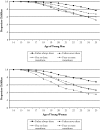Family structure and the transition to early parenthood
- PMID: 20608104
- PMCID: PMC3000024
- DOI: 10.1353/dem.0.0102
Family structure and the transition to early parenthood
Abstract
With the rise in out-of-wedlock childbearing and divorce in the last quarter of the twentieth century, an increasing proportion of children have been exposed to a variety of new family forms. Little research has focused on the consequences of childhood family structure for men's transition to fatherhood or on the family processes that account for the effects of family structure on the likelihood that young women and men become first-time unmarried parents, what we now call "fragile families." The data come from the linked Children and Young Adult samples of the 1979 National Longitudinal Survey of Youth (NLSY79), which provide information on the children of the women of the NLSY79 from birth until they enter young adulthood. Females growing up with a single parent and males experiencing an unstable family transition to parenthood early, particularly to nonresidential fatherhood for males. For males, the effects are strongly mediated by parenting processes and adolescent behaviors and are shaped by economic circumstances. Having experienced multiple transitions as a child is associated with a reduced likelihood that males father their first child within marriage and an increased likelihood that they become fathers within cohabitation, demonstrating how changes in family structure alter family structure patterns over time and generations.
Figures
Similar articles
-
Family pediatrics: report of the Task Force on the Family.Pediatrics. 2003 Jun;111(6 Pt 2):1541-71. Pediatrics. 2003. PMID: 12777595
-
Intergenerational influences on the parent-infant relationship in the transition to parenthood.J Fam Issues. 1985 Dec;6(4):543-64. doi: 10.1177/019251385006004008. J Fam Issues. 1985. PMID: 12340562
-
The role of psychological factors on teenagers who become parents out-of-wedlock.Child Youth Serv Rev. 1997;19(5-6):401-13. doi: 10.1016/s0190-7409(97)00024-8. Child Youth Serv Rev. 1997. PMID: 12295354
-
[Homosexual parenthood and child development: present data].Encephale. 2012 Feb;38(1):10-5. doi: 10.1016/j.encep.2011.05.005. Epub 2011 Jul 5. Encephale. 2012. PMID: 22381718 Review. French.
-
Coming Closer in Adolescence: Convergence in Mother, Father, and Adolescent Reports of Parenting.J Res Adolesc. 2019 Dec;29(4):846-862. doi: 10.1111/jora.12417. Epub 2018 Jun 19. J Res Adolesc. 2019. PMID: 29921030 Free PMC article. Review.
Cited by
-
Family Instability and Pathways to Adulthood in Urban South Africa.Popul Dev Rev. 2013 Jun;39(2):231-256. doi: 10.1111/j.1728-4457.2013.00590.x. Popul Dev Rev. 2013. PMID: 25067862 Free PMC article.
-
The Influence of Parental Educational Attainment on the Partnership Context at First Birth in 16 Western Societies.Eur J Popul. 2017;33(4):533-557. doi: 10.1007/s10680-017-9421-9. Epub 2017 Apr 26. Eur J Popul. 2017. PMID: 29081562 Free PMC article.
-
Family Instability in Childhood and Criminal Offending during the Transition into Adulthood.Am Behav Sci. 2018 Oct;62(11):1483-1504. doi: 10.1177/0002764218787000. Epub 2018 Jul 30. Am Behav Sci. 2018. PMID: 31798181 Free PMC article.
-
Family Histories and Teen Pregnancy in the United States and Canada.J Marriage Fam. 2018 Oct;80(5):1244-1258. doi: 10.1111/jomf.12512. Epub 2018 Jul 26. J Marriage Fam. 2018. PMID: 30555182 Free PMC article.
-
Continuity and Change in U.S. Children's Family Composition, 1968-2017.Demography. 2022 Apr 1;59(2):731-760. doi: 10.1215/00703370-9783507. Demography. 2022. PMID: 35234852 Free PMC article.
References
-
- Albrecht C, Teachman JD. “Childhood Living Arrangements and the Risk of Premarital Intercourse”. Journal of Family Issues. 2003;24:867–94.
-
- Amato PR. “The Consequences of Divorce for Adults and Children”. Journal of Marriage and the Family. 2000;62:1269–87.
-
- Astone NM, McLanahan S. “Family Structure, Residential Mobility, and School Report: A Research Note”. Demography. 1994;31:575–84. - PubMed
-
- Barber JS. “The Intergenerational Transmission of Age at First Birth Among Married and Unmarried Men and Women”. Social Science Research. 2001;30:219–47.
-
- Buchanan CM, Maccoby EE, Dornbusch SM. Adolescents After Divorce. Cambridge, MA: Harvard University Press; 1996.
Publication types
MeSH terms
Grants and funding
LinkOut - more resources
Full Text Sources
Medical
Miscellaneous


